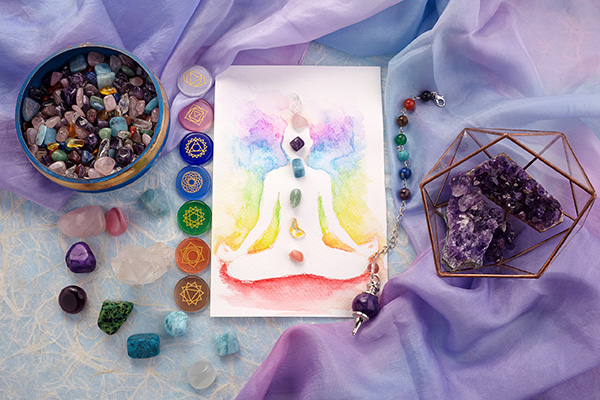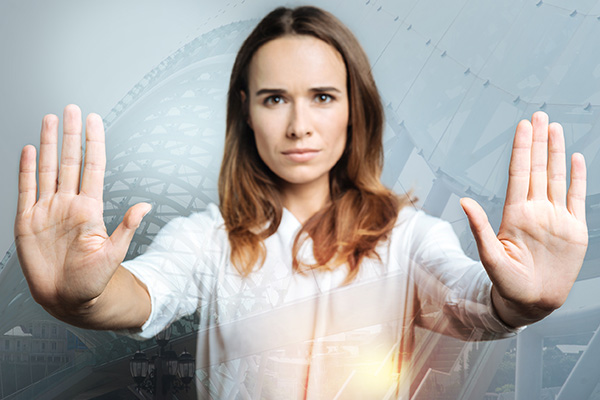energy balance
Protect Yourself From Toxic Noise And Psychic Junk
 How often do you consider the health of your auric space or personal energy field, which is constantly being bombarded with so much negative energy these days. Are you doing enough to protect yourself?
How often do you consider the health of your auric space or personal energy field, which is constantly being bombarded with so much negative energy these days. Are you doing enough to protect yourself?
First and foremost, you need to have healthy boundaries. Each of us needs and deserves to have a safe place, a sense of self-worth, and protection from others. Think about what happens to a beach that is battered constantly by waves. It will wear down and eventually disappear. If you don’t have boundaries, your very identity will be like those grains of sand.
Learning to connect back to the Earth and nature is essential to our well-being. This can be as simple as walking without shoes in a natural space, or by keeping plants in your living space. When we are separate from our natural selves, we lose perhaps the most important part of our soul.
By walking in nature, you are literally reconnecting. Like a lightning bolt discharging energy when it strikes solid ground, you are releasing all the negative energies that accumulate in your body. Take a friend, or walk your dog if you have one.
If these energies, and their associated negative effects, are like frantic little animals in the cage of our bodies, we need to find ways to calm them. Centering rituals using meditation, candles, crystals, or whatever individual tradition you may follow, need to be part of your day, just like meals and baths.
Balance Your Mind With Crystal Energy
 The human brain is a dual force, with the left and right hemispheres complementing each other to create a balanced mind.
The human brain is a dual force, with the left and right hemispheres complementing each other to create a balanced mind.
Each side of the brain brings its own gifts to the whole, working together to shape our unique perceptions and experiences.
The left brain is known for its logical, structured, and analytical approach to processing information, excelling in tasks like reasoning, mathematics, and language.
In contrast, the right brain is more intuitive, imaginative, and emotionally expressive, fueling creativity, visual thinking, and spiritual insight.
This division of cognitive function influences how we think, solve problems, and interact with the world, both internally and externally.
In the realm of energy work and healing, various crystals and stones support and enhance the natural strengths of each brain hemisphere, promoting overall mental and emotional harmony and balance.
Whether you are seeking increased focus for problem solving or a boost in artistic expression, the right combination of crystals can support a harmonious mind that fosters both intellectual and creative growth.
By setting clear intentions and using the appropriate crystals and stones regularly, you can harness their energies to align both hemispheres of the brain and promote an integrated approach to life.
In this sacred balance, the mind and soul find unity, creating a deeper sense of wholeness and fulfillment—a fusion of logic and intuition, structure and flow, thought and feeling.
The Ripple Effect Of Radiating Good Vibes!
 There have been times when leaving home on a miserable day has felt like a major challenge for me as an empath. However, after completing my errands, I often find myself unexpectedly uplifted, simply by the energy of the people and places I encounter.
There have been times when leaving home on a miserable day has felt like a major challenge for me as an empath. However, after completing my errands, I often find myself unexpectedly uplifted, simply by the energy of the people and places I encounter.
Recently, while shopping for a new journal, one particular notebook caught my eye because of the title printed on the cover: Good Vibes. I ended up going back to add it to my cart because those two simple words stuck with me. Some good vibrations are certainly always welcome in today’s chaotic world!
In this particular store, the staff is incredibly friendly, always ready with a smile and a warm greeting. Even the people stocking the shelves take a moment to acknowledge customers, creating a welcoming atmosphere. These small, everyday interactions are still commonplace in the small town where I live in Spain, and long may they continue!
The little notebook and this friendly exchange reminded me that “good vibes” is not just a phrase on a cover, but a very real force that shapes our daily experiences.
As I was driving home thinking about this, I noticed a gentleman who was busy smoothing out some gravel on the country road. He had stopped to have a conversation with the person in the car in front of me.
As I was about to go around them, he said goodbye to the person he was talking to and approached me. My first thought was that he was trying to warn me of a problem on the road ahead or maybe point out a problem with my car. It was drizzling and damp and he was soaked, but when I rolled down my window he just smiled and asked how I was doing.
Practical Techniques For Psychic Protection
 Psychic protection, also known as spiritual or energetic protection, is a practice I hold dear because it helps shield me from negative energies, psychic attacks, and unwanted influences.
Psychic protection, also known as spiritual or energetic protection, is a practice I hold dear because it helps shield me from negative energies, psychic attacks, and unwanted influences.
The concept is not new. Mystical protection practices can be traced back to various ancient civilizations, indigenous traditions, Eastern philosophies, and Western esoteric practices.
In ancient Egypt, Greece, and Rome, amulets and talismans were worn and protective deities invoked to ward off negative energies and evil spirits. Indigenous cultures in the Americas and Africa used smudging and rituals to summon ancestral spirits for protection.
Eastern religious traditions such as Hinduism and Buddhism use mantras, yantras, and meditation for spiritual protection. Kabbalistic traditions emphasize the use of specific prayers and rituals to create spiritual shields. These practices reflect a deep-rooted belief in the power of divine intervention and sacred symbols to provide protection.
In Catholicism, believers recite prayers such as the Lord’s Prayer or the prayer to St. Michael for protection from evil. They may also use holy water, crucifixes, or medals of saints as protective symbols. In Judaism, the recitation of Psalms and the use of amulets inscribed with Hebrew verses are common practices for protection against negative influences.
Contemporary spiritual communities have adapted these ancient practices to include the use of crystals, energy healing, and visualization techniques. Workshops, books, and teachings offer a wealth of methods for psychic protection, all aimed at maintaining a balanced, protected, and positive state of being. These diverse traditions and modern adaptations underscore the universal spiritual need to protect ourselves from unseen negative energies and dark influences.
The Ancient Spiritual Tradition Of Smudging
 Just as our physical environment can become cluttered and unclean, our aura or energy field also accumulates stagnant and negative energy.
Just as our physical environment can become cluttered and unclean, our aura or energy field also accumulates stagnant and negative energy.
Regularly cleaning our homes and workplaces promotes health, hygiene and optimal function — and the same principle applies to our personal and spiritual energy. Clearing our energy field and environment helps to release negativity and toxic emotions, stress and anxiety, and promotes a sense of calm, clarity and balance.
Energy cleansing is essential for removing blockages that may be hindering personal and spiritual growth or disrupting your connection to spirit and the divine. Over time, lingering negative or toxic energy can even manifest as mental health issues, spiritual disconnection and even physical ailments.
By maintaining a regular practice of energy cleansing, you create a positive, harmonious flow of energy that supports overall health and well-being. In addition, a clear energy field sharpens your intuition and inner guidance, making it easier to align with your higher self and make decisions that are aligned with your greatest good.
Smudging is also a powerful way to clear negative energy attachments and banish malevolent spirit entities.
One of the most time-tested and effective methods of clearing unwanted energy is smudging, or smoke cleansing — an ancient purification ritual steeped in history and practiced by various cultures, religions, and spiritual traditions around the world.
Energize Your Chakras With Lithotherapy
 Lithotherapy, also known as crystal healing, is a popular alternative healing method for improving physical, emotional, mental and spiritual well-being.
Lithotherapy, also known as crystal healing, is a popular alternative healing method for improving physical, emotional, mental and spiritual well-being.
But lithotherapy is far from a modern trend. This healing modality has its origins in ancient civilizations, and many indigenous cultures around the world have traditionally used stones and other natural elements in their healing practices, rituals and ceremonies.
Derived from the Greek words lithos (stone) and therapeia (healing), this ancient art harnesses the energies of crystals, stones and minerals that interact with the human energy field to promote energy flow, alignment and balance.
Lithotherapy uses the natural energies of the earth for a holistic approach to healing without the use of synthetic chemicals or man-made materials.
Today, lithotherapy is a staple of alternative medicine and energy healing, and the practice has gained widespread popularity in recent years as more people now incorporate crystals and stones into their lifestyle and spiritual practice.
Each crystal has unique metaphysical properties, allowing practitioners to choose stones that resonate with their specific needs and intentions. One of the most common uses is chakra energy work to clear, balance, and align the body’s energy centers, known as the chakras.
Each of the chakras corresponds to specific physical, mental, emotional or spiritual aspects of our being, and certain crystals, stones and minerals resonate with each of these energy centers to help restore energy flow, function, balance and wellness.
Reclaim Your Peace And Power With Healthy Boundaries
 Saying “no” is one of the most powerful things we can do to maintain our personal and spiritual well-being and energetic balance.
Saying “no” is one of the most powerful things we can do to maintain our personal and spiritual well-being and energetic balance.
Many of us are caught up in the daily whirlwind of commitments, expectations, and the constant need to meet the demands of others. For those on a spiritual or esoteric path, this can be especially challenging.
The desire to be compassionate and supportive can sometimes blur the lines between compassion and self-neglect. However, one of the most profound spiritual lessons is this: it is okay to say no. In fact, it is imperative!
Knowing when and how to say no is a critical self-care skill that allows you to set healthy boundaries and protect your time, energy, and mental health. Moreover, it is crucial for our spiritual growth and essential for living a life filled with purpose and fulfillment.
Saying no and standing your ground requires recognizing your inherent worth and honoring your personal limits. Too often we stretch ourselves too thin, trying to be all things to all people. This may come from a fear of disappointing others or a belief that our value is in how much we give. Many of us also feel spiritually obligated to be there for others, often because we are so deeply affected by all the struggles and suffering we see in the world around us.
However, when we put the needs of others ahead of our own without balance, we risk depleting our physical, emotional, and spiritual energy. In such a depleted state, we are of no use to anyone.